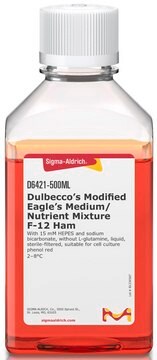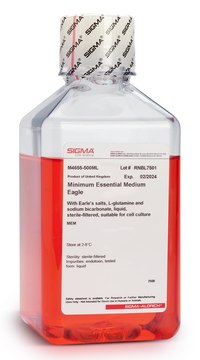N6658
Nutrient Mixture F-12 Ham
With ʟ-glutamine and sodium bicarbonate, liquid, sterile-filtered, suitable for cell culture
Synonym(s):
Ham’s F-12
Sign Into View Organizational & Contract Pricing
All Photos(1)
About This Item
Recommended Products
Product Name
Nutrient Mixture F-12 Ham, With L-glutamine and sodium bicarbonate, liquid, sterile-filtered, suitable for cell culture
Quality Level
sterility
sterile-filtered
form
liquid
technique(s)
cell culture | mammalian: suitable
impurities
endotoxin, tested
components
L-glutamine: yes
HEPES: no
phenol red: yes
sodium pyruvate: 0.11 g/L
NaHCO3: yes
shipped in
ambient
storage temp.
2-8°C
Looking for similar products? Visit Product Comparison Guide
General description
Ham′s Nutrient Mixtures were mainly created to support the clonal growth of numerous clones of Chinese hamster ovary (CHO) cells and clones of HeLa and mouse L-cells. It is also used to grow primary rat hepatocytes and rat prostate epithelial cells. Ham′s F-12 is used as the medium of choice for a clonal toxicity assay using CHO cells.
Application
Nutrient Mixture F-12 Ham has been used:
- to culture Chinese hamster ovary cells overexpressing insulin receptor (CHO-IR)
- to culture LAN-1 cells
- to maintain SUM149, SUM159, SUM190, FC-IBC02, BCX010, and IBC3 cells
- with Dulbecco’s modified Eagle’s medium (DMEM) media in a 1:1 ratio to culture oral cavity squamous cell carcinoma (OSCC) cell lines.
also commonly purchased with this product
Product No.
Description
Pricing
supplement
Product No.
Description
Pricing
Storage Class Code
12 - Non Combustible Liquids
WGK
WGK 1
Flash Point(F)
Not applicable
Flash Point(C)
Not applicable
Choose from one of the most recent versions:
Already Own This Product?
Find documentation for the products that you have recently purchased in the Document Library.
Customers Also Viewed
Lilla Krokker et al.
Pathology oncology research : POR, 27, 640676-640676 (2021-07-15)
In vitro monolayer conditions are not able to reproduce the complexity of solid tumors, still, there is scarce information about the 3D cell culture models of endocrine tumor types. Therefore, our aim was to develop in vitro 3D tumor models
Kazuko Yokota et al.
Annals of surgical oncology, 26(13), 4826-4834 (2019-09-25)
WiNTRLINC1 is a long non-coding RNA (lncRNA) that positively regulates the Wnt pathway via achaete-scute complex homolog 2 (ASCL2) in colorectal cancer. ASCL2 was recently reported to play a critical role in chemoresistance, however clinical relevance of the WiNTRLINC1/ASCL2 axis
Yoshinobu Takahashi et al.
Oncology letters, 14(1), 264-270 (2017-07-12)
Whether the poor prognosis of primary central nervous system lymphoma (PCNSL) compared with systemic diffuse large B cell lymphoma (DLBCL) is attributable to the immune privilege of the intracerebral location or to intrinsic differences in the biological characteristics of two
Toshimichi Tanaka et al.
Annals of surgical oncology, 26(5), 1401-1411 (2019-02-02)
Treatment-resistance genes limiting anticancer therapy have not been well clarified in colorectal cancer (CRC). We explored gene expression profiles to identify biomarkers for predicting treatment resistance to an anticancer drug in CRC. Six CRC cell lines were treated with phenylbutyrate
Jianjia Fan et al.
Journal of lipid research, 59(5), 830-842 (2018-03-23)
apoE is the primary lipid carrier within the CNS and the strongest genetic risk factor for late onset Alzheimer's disease (AD). apoE is primarily lipidated via ABCA1, and both are under transcriptional regulation by the nuclear liver X receptor (LXR).
Our team of scientists has experience in all areas of research including Life Science, Material Science, Chemical Synthesis, Chromatography, Analytical and many others.
Contact Technical Service






